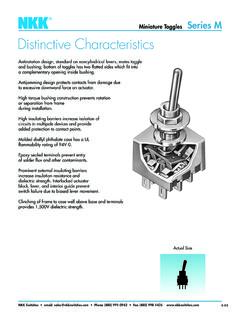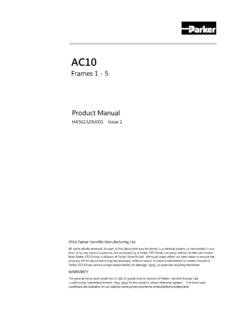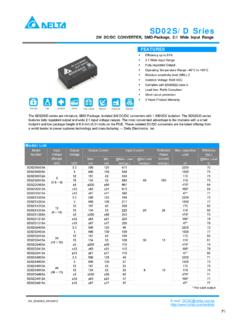Transcription of LTC1144 - Switched-Capacitor Wide Input Range Voltage ...
1 1 LTC1144 Switched-CapacitorWide Input RangeVoltage Converterwith ShutdownUAOPPLICATITYPICALO utput Voltage vs Load Current, V+ = 15 VSFEATUREDUESCRIPTIOnWide Operating Supply Voltage Range : 2V to 18 VnBoost Pin (Pin 1) for Higher Switching FrequencynSimple Conversion of 15V to 15V SupplynLow Output Resistance: 120 MaximumnPower Shutdown to 8 A with SHDN PinnOpen Circuit Voltage Conversion TypicalnPower Conversion Efficiency: 93% TypicalnEasy to UseThe LTC1144 is a monolithic CMOS switched-capacitorvoltage converter. It performs supply Voltage conversionfrom positive to negative from an Input Range of 2V to 18V,resulting in complementary output voltages of 2V to 18V.
2 Only two noncritical external capacitors are neededfor the charge pump and charge reservoir converter has an internal oscillator that can beoverdriven by an external clock or slowed down whenconnected to a capacitor. The oscillator runs at a 10kHzfrequency when unloaded. A higher frequency outside theaudio band can also be obtained if the Boost Pin is tied toV+. The SHDN pin reduces supply current to 8 A and canbe used to save power when the converter is not in LTC1144 contains an internal oscillator, divide-by-two, Voltage level shifter, and four power MOSFETs. Aspecial logic circuit will prevent the power N-channelswitch substrate from turning of 15V to 15V SuppliesnInexpensive Negative SuppliesnData Acquisition SystemsnHigh Voltage Upgrade to LTC1044 or 7660nVoltage Division and MultiplicationsnAutomotive ApplicationsnBattery Systems with Wall Adapter/ChargerLOAD CURRENT (mA)010 OUTPUT Voltage (V) 15 14 13 12 11 10401144 TA02203050 ROUT = 56 TA = 25 C1 2 3 48 7 6 5 BOOST CAP+ GND CAP V+ OSC SHDN VOUT++10 F 15V OUTPUT15V INPUTLTC114410 F1144 TA01 Generating 15V from 15V2 LTC1144 WUUPACKAGE/ORDER I FOR ATIOAUGWAWUWARBSOLUTEXITIS(Note 1)Supply Voltage (V+) (Transient).
3 20 VSupply Voltage (V+) (Operating) .. 18 VInput Voltage on Pins 1, 6, 7(Note 2) .. < VIN < (V+) + Short-Circuit DurationV+ 10V .. IndefiniteV+ 15V .. 30 secV+ 20V .. Not ProtectedPower Dissipation .. 500mWOperating Temperature RangeLTC1144C .. 0 C to 70 CLTC1144I .. 40 C to 85 CStorage Temperature Range .. 65 C to 150 CLead Temperature (Soldering, 10 sec) .. 300 CTOP VIEW1 2 3 48 7 6 5 BOOST CAP+ GND CAP V+ OSC SHDN VOUTS8 PACKAGE 8-LEAD PLASTIC SOIC TJMAX = 110 C, JA = 130 C/W1 2 3 48 7 6 5 TOP VIEWBOOST CAP+ GND CAP V+ OSC SHDN VOUTN8 PACKAGE 8-LEAD PLASTIC DIP TJMAX = 110 C, JA = 100 C/WS8 PART MARKING11441144 ILTC1144CS8 LTC1144IS8 LTC1144CN8 LTC1144IN8 ORDER PARTNUMBERC onsult factory for Military grade l denotes specifications which apply over the full operatingtemperature Range .
4 All other limits and typicals at TA = 25 1: Absolute maximum ratings are those values beyond which the lifeof a device may be 2: Connecting any Input terminal to voltages greater than V+ or lessthan ground may cause destructive latch-up. It is recommended that noinputs from sources operating from external supplies be applied prior topower-up of the 3: fOSC is tested with COSC = 100pF to minimize the effects of testfixture capacitance loading. The 0pF frequency is correlated to this 100pFtest point, and is intended to simulate the capacitance at pin 7 when thedevice is plugged into a test socket and no external capacitor is PARAMETERCONDITIONSMINTYPMAXMINTYPMAXUNI TSS upply Voltage RangeRL = 10kl218218 VISS upply CurrentRL = , Pins 1, 6 No Connection, = = 0V, RL = , Pins 1, ConnectionV+ = 5V, RL = , Pins 1, Connection, fOSC = + = 5V, SHDN = 0V, RL = , 1, 7 No ConnectionROUTO utput ResistanceV+ = 15V, IL = 20mA at 10kHz5610056100 l120140 V+ = 5V, IL = 3mA at 4kHzl9025090300 fOSCO scillator FrequencyV+ = 15V (Note 3)
5 1010kHzV+ = 5V44kHzPower EfficiencyRL = 2k at 10kHzl90939093% Voltage Conversion EfficiencyRL = Sink or Source CurrentV+ = 5V (VOSC = 0V to 5V) AV+ = 15V (VOSC = 0V to 15V)44 AELECTRICAL CCHARA TERISTICSV+ = 15V, COSC = 0pF, TA = 25 C, Test Circuit Figure 1, unless otherwise PERFORMANCE CHARACTERISTICS UWSUPPLY Voltage (V)2 OSCILLATOR FREQUENCY (kHz)1010010006101448121618 LTC1144 TPC031TA = 25 C COSC = 0 BOOST = V+BOOST = OPEN OR GROUNDO scillator Frequencyvs Supply VoltageOutput Resistancevs Supply VoltageSUPPLY Voltage (V)20 OUTPUT RESISTANCE ( )501001502006 101418 LTC1144 TPC01250300481216TA = 25 CTEMPERATURE ( C) 55 OUTPUT RESISTANCE ( )1001201402575 LTC1144 TPC028060 250501001254020V+ = 5V IL = 3mAV+ = 15V IL = 20mAOutput Resistance vs TemperatureOscillator Frequencyvs TemperatureOutput Voltage vs Load CurrentOscillator Frequency as aFunction of COSCEXTERNAL CAPACITANCE (PIN 7 TO GND), COSC (pF)1 OSCILLATOR FREQUENCY (kHz)11010000 LTC1144 = 25 C V+ = 15 VBOOST = OPEN OR GROUNDBOOST = V+LOAD CURRENT (mA)0 15 OUTPUT Voltage (V) 10 5010203040 LTC1144 TPC065060TA = 25 C V+ = 15V C1 = C2 = 10 F BOOST = OPENROUT = 56 TEMPERATURE ( C) 55 25 OSCILLATOR FREQUENCY (kHz)
6 1010010000255075100125 LTC1144 TPC051 BOOST = V+BOOST = OPEN OR GROUNDTA = 25 C V+ = 15 VPower Conversion Efficiency andSupply Current vs Load CurrentLOAD CURRENT (mA)0 5 OUTPUT Voltage (V) 4 3 2 105101520 LTC1144 TPC072530TA = 25 C V+ = 5V C1 = C2 = 10 F BOOST = OPENROUT = 90 Output Voltage vs Load CurrentSupply Current as a Function ofOscillator FrequencyOSCILLATOR FREQUENCY (kHz) CURRENT ( A)1001000100 LTC1144 = 25 C C1 = C2 = 10 FV+ = 15VV+ = 5 VLOAD CURRENT (mA)0 POWER CONVERSION EFFICIENCY (%)SUPPLY CURRENT (mA)608010040 LTC1144 TPC094020060801004020010203050 PEFFISTA = 25 C V+ = 15V C1 = C2 = 10 F BOOST = OPEN (SEE TEST CIRCUIT)4 LTC1144 TYPICAL PERFORMANCE CHARACTERISTICS UWPower Conversion Efficiency andSupply Current vs Load CurrentOSCILLATOR FREQUENCY (kHz) RESISTANCE ( )20003000110100 LTC1144 TPC1210001 F10 F100 FTA = 25 C V+ = 15 VOSCILLATOR FREQUENCY (kHz) CONVERSION EFFICIENCY (%)9095100110100 LTC1144 TPC11858075TA = 25 C, V+ = 15V BOOST = OPENIL = 20mAIL = 3mA1 F1 F10 F10 F100 F100 FPower Conversion Efficiencyvs Oscillator FrequencyOutput Resistancevs Oscillator FrequencyOutput Voltage vs Load CurrentLOAD CURRENT (mA) 10 OUTPUT Voltage (V) TPC15 + = 15V TA = 25 C C1 = C2 BOOST = F1 F1 F10 F10 FBOOST = OPENO utput Voltage vs Load CurrentLOAD CURRENT (mA)
7 4 OUTPUT Voltage (V) 3 2 G14 F10 F10 F1 F1 FV+ = 5V TA = 25 C C1 = C2 BOOST = 5 VBOOST = OPENLOAD CURRENT (mA) Voltage (mV)50010001 F1 F10 F10 FV+ = 5V TA = 25 C C1 = C2 BOOST = 5 VBOOST = FRipple Voltage vs Load CurrentPI FU CTIO S UUUB oost (Pin 1): This pin will raise the oscillator frequencyby a factor of 10 if tied + (Pin 2): Positive Terminal for Pump (Pin 3): Ground (Pin 4): Negative Terminal for Pump (Pin 5): Output of the (Pin 6): Shutdown Pin. Tie to V+ pin or leave floatingfor normal operation. Tie to ground when in (Pin 7): Oscillator Input Pin. This pin can be overdrivenwith an external clock or can be slowed down by connect-ing an external capacitor between this pin and + (Pin 8).
8 Input CURRENT (mA)0 POWER CONVERSION EFFICIENCY (%)SUPPLY CURRENT (mA)608010016 LTC1144 TPC104020030405020100481220 PEFFISTA = 25 C V+ = 5V C1 = C2 = 10 F BOOST = OPEN (SEE TEST CIRCUIT)5 LTC1144 TEST CIRCUITSF igure 2 3 48 7 6 5 ++C1 10 FC2 10 FISVOUTV+ 15 VILRLEXTERNAL OSCILLATORCOSC1144 F01 LTC1144 USAOPPLICATIWUUI FOR ATIOT heory of OperationTo understand the theory of operation of the LTC1144 , areview of a basic Switched-Capacitor building block Figure 2, when the switch is in the left position, capacitorC1 will charge to Voltage V1. The total charge on C1 will beq1 = C1V1. The switch then moves to the right, discharg-ing C1 to Voltage V2. After this discharge time, the chargeon C1 is q2 = C1V2.
9 Note that charge has been transferredfrom the source V1 to the output V2. The amount of chargetransferred is: q = q1 q2 = C1(V1 V2)V2 RLC2C1V1f1144 F02 Figure 2. Switched-Capacitor Building BlockIf the switch is cycled f times per second, the chargetransfer per unit time ( , current) is:I = f q = f C1(V1 V2)Rewriting in terms of Voltage and impedance equivalence,IVVfCVVREQUIV= = 121112A new variable REQUIV has been defined such that REQUIV= 1/ (f C1). Thus, the equivalent circuit for the Switched-Capacitor network is as shown in Figure 3. Switched-Capacitor Equivalent CircuitV2 RLREQUIVC2V11144 F03 REQUIV =1 f C1 Examination of Figure 4 shows that the LTC1144 has thesame switching action as the basic switched-capacitorbuilding block.
10 With the addition of finite switch on-resistance and output Voltage ripple, the simple theory,although not exact, provides an intuitive feel for how thedevice example, if you examine power conversion efficiencyas a function of frequency (see Figure 5), this simpletheory will explain how the LTC1144 behaves. The loss,Figure 4. LTC1144 Switched-CapacitorVoltage Converter Block DiagramSHDN (6)OSC (7)10X (1)BOOST1144 F04 OSC 2V+ (8)SW1SW2 CAP+ (2)CAP (4)GND (3)VOUT (5)C2C1++ 6 LTC1144and hence the efficiency, is set by the output frequency is decreased, the output impedance willeventually be dominated by the 1/ (f C1) term and powerefficiency will also that power efficiency decreases as frequencygoes up.


















